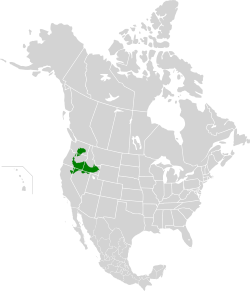The Snake–Columbia shrub steppe is an ecoregion defined by the World Wide Fund for Nature (WWF). This ecoregion receives little precipitation because it is within the rain shadow of the Cascade Range. It takes in a western portion of the Columbia Basin in Washington, and extends south along the Deschutes River Basin, expanding to cover most of southeast Oregon including the Oregon Lakes region. This ecoregion reaches south from Oregon into northern Nevada and the northeast corner of California. It also connects east onto the Snake River Plain, which it follows east from Hells Canyon to the continental divide in eastern Idaho.[2]
| Snake–Columbia shrub steppe | |
|---|---|
 Shrub-steppe of Hagerman Fossil Beds National Monument, Idaho | |
 | |
| Ecology | |
| Realm | Nearctic |
| Biome | Deserts and xeric shrublands |
| Borders | |
| Bird species | 207[1] |
| Mammal species | 104[1] |
| Geography | |
| Area | 218,077[2] km2 (84,200 sq mi) |
| Country | United States |
| States | |
| Climate type | Cold desert (BWk) and cold semi-arid (BSk) |
| Conservation | |
| Habitat loss | 19.112%[1] |
| Protected | 58.45%[1] |
Information about this ecoregion is covered by three articles that follow the ecoregion definitions of the United States Environmental Protection Agency:
See also
References
External links
Wikiwand in your browser!
Seamless Wikipedia browsing. On steroids.
Every time you click a link to Wikipedia, Wiktionary or Wikiquote in your browser's search results, it will show the modern Wikiwand interface.
Wikiwand extension is a five stars, simple, with minimum permission required to keep your browsing private, safe and transparent.
